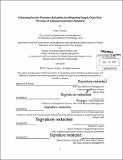| dc.contributor.advisor | Retsef Levi and David Simchi-Levi. | en_US |
| dc.contributor.author | Golany, Yanai S | en_US |
| dc.contributor.other | Leaders for Global Operations Program. | en_US |
| dc.date.accessioned | 2014-10-08T15:28:49Z | |
| dc.date.available | 2014-10-08T15:28:49Z | |
| dc.date.copyright | 2014 | en_US |
| dc.date.issued | 2014 | en_US |
| dc.identifier.uri | http://hdl.handle.net/1721.1/90782 | |
| dc.description | Thesis: M.B.A., Massachusetts Institute of Technology, Sloan School of Management, 2014. In conjunction with the Leaders for Global Operations Program at MIT. | en_US |
| dc.description | Thesis: S.M., Massachusetts Institute of Technology, Engineering Systems Division, 2014. In conjunction with the Leaders for Global Operations Program at MIT. | en_US |
| dc.description | Appendix printed landscape. Cataloged from PDF version of thesis. | en_US |
| dc.description | Includes bibliographical references (pages 48-49). | en_US |
| dc.description.abstract | Service providers rely on the continuity of their service to sustain their businesses. While at first glance it may seem that service providers are not as dependent on their supply chain as product companies are, a closer look of some relevant systems shows that a stable and resilient supply chain is a key for both maintaining service and growing it. A wireless network provider which does not have spare parts in place to maintain existing cell sites will see an increase in outage duration and, thereby, customer churn. A cable/satellite service provider which does not have the equipment at the right place and in time to expand to a new market will see competitors capturing customers. In order to eliminate or at least mitigate these types of business risks for service providers, a transformation of the Time to Recovery (TTR) / Time to Survive (TTS) framework is shown to fit the service domain. TTR represents the time it takes for a supply chain system to recover from a disrupted supplier. TTS represents the time a supply chain system can continue to operate while its sources of supply are disrupted. The key metric which is introduced is value of service, which allows us to measure the actual lost value as a result of service disruptions. | en_US |
| dc.description.statementofresponsibility | by Yanai S. Golany. | en_US |
| dc.format.extent | 54 pages | en_US |
| dc.language.iso | eng | en_US |
| dc.publisher | Massachusetts Institute of Technology | en_US |
| dc.rights | M.I.T. theses are protected by copyright. They may be viewed from this source for any purpose, but reproduction or distribution in any format is prohibited without written permission. See provided URL for inquiries about permission. | en_US |
| dc.rights.uri | http://dspace.mit.edu/handle/1721.1/7582 | en_US |
| dc.subject | Sloan School of Management. | en_US |
| dc.subject | Engineering Systems Division. | en_US |
| dc.subject | Leaders for Global Operations Program. | en_US |
| dc.title | Enhancing service providers reliability by mitigating supply chain risk : the case of telecommunication networks | en_US |
| dc.type | Thesis | en_US |
| dc.description.degree | M.B.A. | en_US |
| dc.description.degree | S.M. | en_US |
| dc.contributor.department | Leaders for Global Operations Program at MIT | en_US |
| dc.contributor.department | Massachusetts Institute of Technology. Engineering Systems Division | |
| dc.contributor.department | Sloan School of Management | |
| dc.identifier.oclc | 891568426 | en_US |
